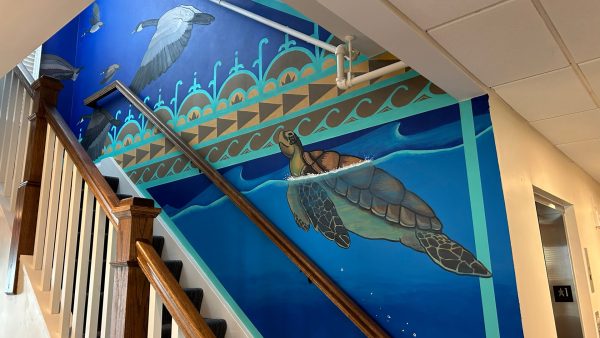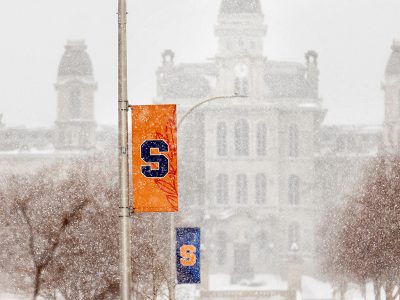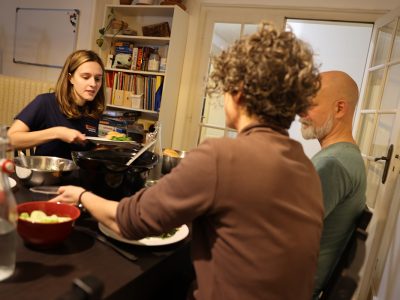What Does Seventh-Generation Thinking Mean?
When Haudenosaunee gather for a meal or event, they begin with the Thanksgiving Address. “Today we have gathered and we see that the cycles of life continue,” opens this statement of values, translated from the Mohawk version to English. “We have been given the duty to live in balance and harmony with each other and all living things.”
“The Thanksgiving Address is a valuable act of remembering, and it is meant to have the opposite effect than taking something for granted,” says Scott Manning Stevens, associate professor and director of the Center for Global Indigenous Cultures and Environmental Justice (CGIC) at the College of Arts and Sciences.
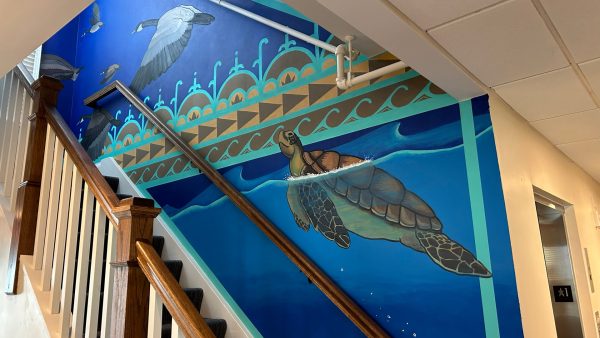
“It’s meant to slow time down and produce mindfulness and keep attention on key values,” he continues. “What does it really mean to pause and give thanks to all of the things that make our lives so much better?”
The answers not only broaden students’ cultural literacy, but may help create a more just world as it faces existential questions amid the climate crisis and rampant inequality.
“We want to support those Indigenous societies that are trying to maintain their traditional values, much of which we now call sustainable practices,” says Stevens, a citizen of the Akwesasne Mohawk Nation. (The Haudenosaunee include the Mohawk Nation as well as the Oneida, Cayuga, Onondaga, Seneca and Tuscarora nations.)
The center was created as part of a three-year, $1.5 million Andrew W. Mellon Foundation grant to strengthen Indigenous studies at Syracuse University.
“We want to make these concepts more understandable to a larger public and show there are intellectual and ethical resources that Indigenous communities offer by reaching back to our values,” Stevens says.
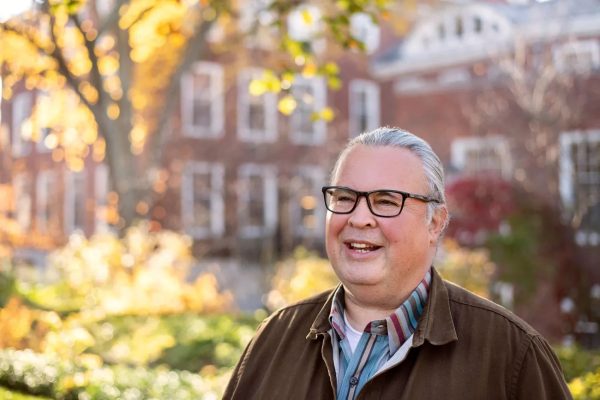
The center draws broadly from the rich culture of the Haudenosaunee, on whose ancestral land the University is located. Meanwhile, a diverse faculty that includes Percy Abrams, citizen of the Onondaga Nation; Melissa Chipman, who is of Cherokee descent; Mariaelena Huambachano, Quechua, Peru; Aaron Luedtke, Suquamish descent; Danika Medak-Saltzman, citizen of the Turtle Mountain Chippewa Nation; and guest speakers share perspectives from a variety of Indigenous communities.
Contributions from diverse Indigenous experts help students get firsthand descriptions of Native communities and their challenges. And the approach reinforces that not all Indigenous people are the same. “There are key concepts across cultures, but obviously there are different techniques among different people,” Stevens says. “We should be aware that one size does not fit all.”
A New Perspective for Students
The center aims to introduce students to a new way of thinking about broad issues like interconnectedness, equity, responsibility and respect. It then challenges students to apply broad Indigenous concepts to concrete practices, such as those related to climate change, land stewardship and sovereignty.
Ethical Land Use
Take ethical land use, for example. “Ask permission before taking. Abide by the answer. Never take the first. Never take the last. Take only what you need,” Robin Kimmerer wrote in her bestselling book “Braiding Sweetgrass: Indigenous Wisdom, Scientific Knowledge and the Teachings of Plants.” Kimmerer, an enrolled member of the Citizen Potawatomi Nation, is a SUNY College of Environmental Science and Forestry professor of biology with an appointment at the center.
“That sounds easy enough, but of course that is not the premise of capitalism, which is to take as much as you can and sell it back at a profit,” Stevens says, pointing to practices like fracking and extracting minerals that strip the land. Those actions, he said, typically enrich some people at the cost of irreparably damaging the land and displacing local communities.
“It is Western capitalist practices that got us in the situation we are in today and Indigenous values that could save us,” Stevens said. “We’re not saying we all should be living with so much less, but that there are different ways we can get what we need.”
One example is farming practices. Most Indigenous farmers practice intercropping—growing several species of plants together, rather than harvesting just one crop in a field. It’s not just that corn, beans and squash—the Haudenosaunee and Cherokee Three Sisters—taste delicious together, but they’re grown in a circle rather than a line because that’s how they grow best.
“Through long observation of nature and the way things work best over millennia, they recognized which plants are symbiotic with each other,” Stevens explains. “We now know the science that beans structurally pull nitrates out of the air and corn wants a nitro-rich environment and beans are bringing the nutrients. The beans grow up and do not hurt the stalks. The squash is ground cover and provides moisture and protects it from insects.”
Food Sovereignty
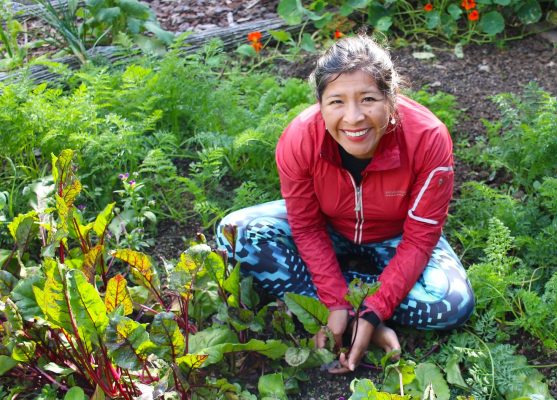
The center co-sponsored a conference on food sovereignty in 2023. Stevens explains the concept: “If political sovereignty is the recognized right to govern oneself, and linguistic sovereignty is the right to speak your own language, food sovereignty is the right to eat the foods your ancestors did. … We don’t eat the same way as our ancestors because often we can’t.”
Huambachano, an Indigenous scholar, lived for many years in Aotearoa, the Indigenous name for New Zealand, and teaches courses including Food Fights and Treaty Rights, Indigenous Food Cosmologies and Reclaiming Indigenous Intellectual Sovereignty. Her new book, “Recovering Our Ancestral Foodways: Indigenous Traditions as a Recipe for Living Well,” was just released this past August by the University of California Press.
Food sovereignty “is more than meeting caloric needs,” Huambachano says. It encompasses a community’s autonomy and right to control its food systems, and includes spiritual nourishment, cultural history and long-term health, she says.
“Unfortunately,” she says, “environmental degradation, the loss of rights to ancestral fishing areas and hunting grounds, and the impacts of climate change and industrial food systems have eroded food sovereignty for many Indigenous communities. They can no longer grow and enjoy our ancestors’ gifts—food—and instead consume processed foods, with harmful effects on their health and well-being.”
Rematriation
Many traditional women’s roles and authority in Indigenous cultures “were eroded with the patriarchy that came with Christianity,” Stevens says. “Rematriation’s goal is to identify and reclaim that identity. It recognizes that our community is made up of all people and all people have something to give.”
In 2023, Huambachano organized “Rematriating Well-Being: Indigenous Foodways, Sovereignty and Sowing Seeds of Hope for Tomorrow,” a symposium that brought together Māori, Quechua and Onondaga women leading the Indigenous food sovereignty movement.
Today, the center is collaborating with the Haudenosaunee women-led organization Rematriation to present the symposium Haudenosaunee & Indigenous Matrilineality Feb. 28-March 2, 2025. Rematriation’s founder, Michelle Schenandoah G’19, is a traditional member of the Wolf Clan of the Haudenosaunee Confederacy and a College of Law adjunct professor affiliated with CGIC. Through film production, digital content creation and community engagement, Rematriation focuses on uplifting Indigenous women’s voices and reclaiming their place in the world.
The spring symposium’s theme also parallels CGIC’s mission: to share principles of Haudenosaunee and Indigenous matrilineal knowledge to address critical global challenges. “We acknowledge this moment in our world and the necessity to share what we know about the important role of women to return balance in our connection to Mother Earth and for everyone’s survival,” Schenandoah says.
For the Seventh Generation
The center’s focus is timely and relevant as we face the existential threats of climate change, Stevens says. The Western view, rooted in the Old Testament, favors “dominion” over the land (Genesis 1:26-28). The Indigenous view generally sees nature and the land as things to live well with, as the Thanksgiving Address reminds us.
“Our relationship to land has much more to do with responsibility than rights. It’s not my right to tear it up because I own it, or I own it so I’m going to frack it. There’s something about the Western tradition that is very short-sighted: We’re going to move forward and create progress and if it creates problems, we can fix it with progress.”
The Haudenosaunee concept of the Seventh Generation (considering the welfare of seven generations into the future before taking any action) “makes us be responsible,” Stevens says. “Should we allow this dam or road to be put in our territory? We have to get together to think: How will this affect the Seventh Generation? It’s an act of imagination, not research. There is no data. It looks good right now to have that road. If you are in the Seventh Generation, what do you think about our decision?”
He does not expect the center itself to solve the big, ethical questions around land use, technology and environmental degradation. Nor does he want students to see Western and Indigenous practices as binary perspectives completely at odds with each other.
“I see the passion of our students for a better world,” he says. “I want to make sure part of their University experience makes this perspective appealing and knowable and recognize there’s another way to do business. It can make the business better.”
